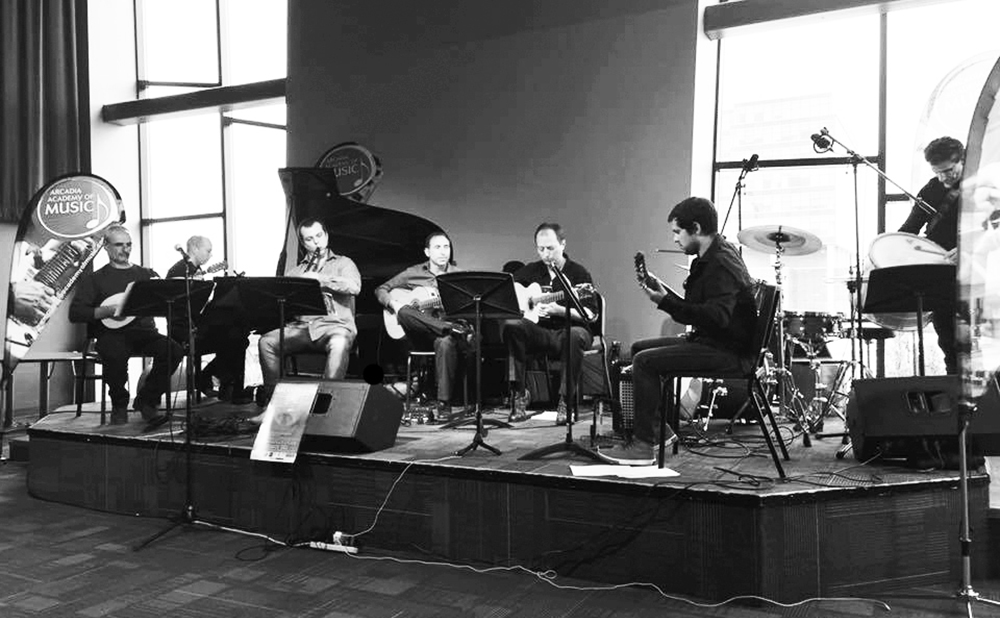Dennis Bayazitov | Contributor
Featured image: Listeners were dazzled by the Balkan Duende at the Martin Family Lounge. | Courtesy of Judy Karacs
The sheer complexity of rhythm and melody in the traditional folk music of the Balkans made its way to eager ears at York. On September 29 at the Martin Family Lounge in Accolade East, music students at York had the pleasure of experiencing this rare musical treat.
Upon entering the lounge, students, professors and alumni immediately saw the warmly lit stage sitting in front of a gloomy backdrop of rain and construction outside. As the lounge steadily filled, the audience was intrigued by the host of unconventional instruments featured.
Toronto composer, collaborator and teacher Anton Apostolov announced the aim of the Bulgarian-Balkan ensemble: to highlight the complexity of Balkan music and demonstrate its significance to and fusion with more popular music.
Joining him on stage were Valeri Dimchev on the tamboura, Scott Metcalfe on piano, Nikola Gaidarov on the kaval, Apostolov and Jacek Karlowski on guitar, Justin Gray on bass and Stoyan Yankoulov on the tupan.
Yankoulov came to the front to explain the unique drum wrapped around his shoulder: the tupan, a two-headed drum originating from second-century Turkey and Greece. Two different sticks are used to play this, he explains, and can produce a number of sounds. Yankoulov links it back to rock music by showing how the thicker stick, the ukanj, is used to hit the thicker-skinned head, producing more accented, deeper blows, much like a kick drum or snare. The thinner stick, the pracka, hits the thinner-skinned head and creates accompanying rhythms like the cymbals. He demonstrates by soloing traditional Bulgarian rhythms, then finishing with a rock groove. His performance pays homage to the traditional tupan but seamlessly brings in a modern rock flare, exposing the audience to sounds they may not have heard before in an intriguing way.
The tambura, a Bulgarian eight-stringed folk instrument, bears similarities to a guitar. Setting up the piece he wrote, Dimchev explains how in Bulgarian folk music, everything is played horizontally—meaning there is no vertical harmonizing taking place on a staff, which is syncing chords with melodies. In Bulgaria, everybody simply plays their own melodies, complementing the whole.
It provides a nice contrast to how music is typically read and composed. Even though Dimchev shows the likeness between a tambura and a guitar, the regional flavour of the tambura is never compromised. As such, when Dimchev and the other artists play their sets, it isn’t in competition with their Western instrument cousins, but in conversation with them.
Before they finish, Gaidarov steps down to showcase the kaval, a Bulgarian reeded flute. He plays “Flight of the Bumblebee” to illustrate its chromatic tone layout. Originally a flute for directing sheep, this eight-holed dogwood flute eventually established itself as a popular Balkan folk instrument. The horizontal way of playing music, combined with the flute, create an organic sense to their music. The artists and the sounds they create appear to form naturally out of the lounge, engaging not only the ears but the bodies and minds of the listeners.
To end the performance, Yankoulov sat behind a drum kit by himself to play a Bulgarian jazz fusion piece, continuing it over and over again. Whenever the audience thought that he was done playing, he continued every time. This hammers home the idea of their odd meter, illustrated beautifully through a jazz fusion style that still manages to feature the Bulgarian traditional sound.


